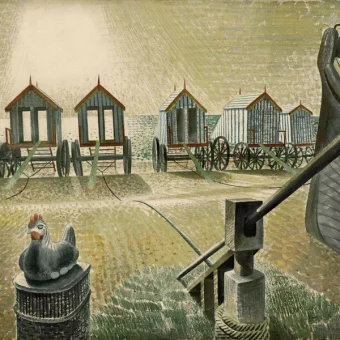ON this day in photos: February 23, 1945: US raises flag raised over Iwo Jima.
Joe Rosenthal took the wonderful picture as the U.S. Marines of the 28th Regiment, 5th Division, raised the American flag atop Mt. Suribachi.
This picture won the Pulitzer Prize in 1945.
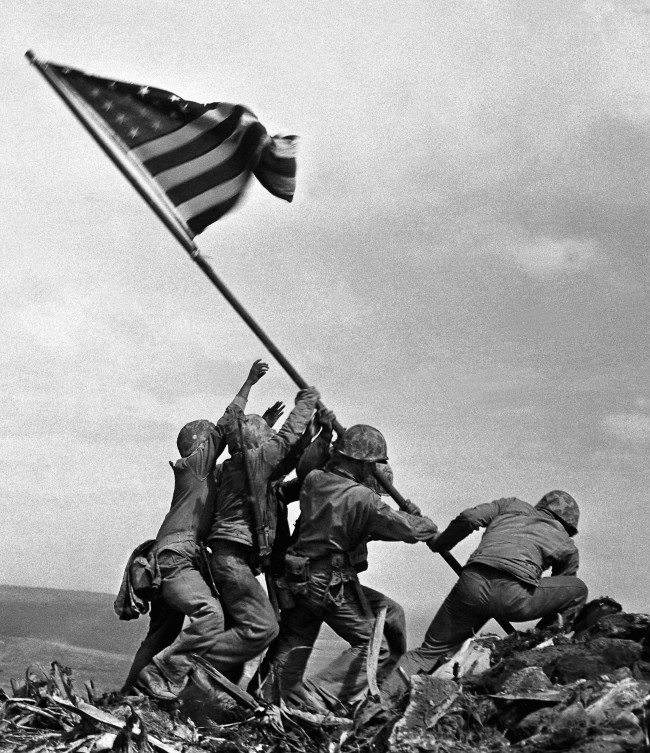
Iwo Jima is 650 miles (1,045 kms) from Tokyo. From there, the US could launch its attack on the Japanese capital. The batter was not over. The Japanese had constructed underground defences – tunnels linking pillboxes and caves.
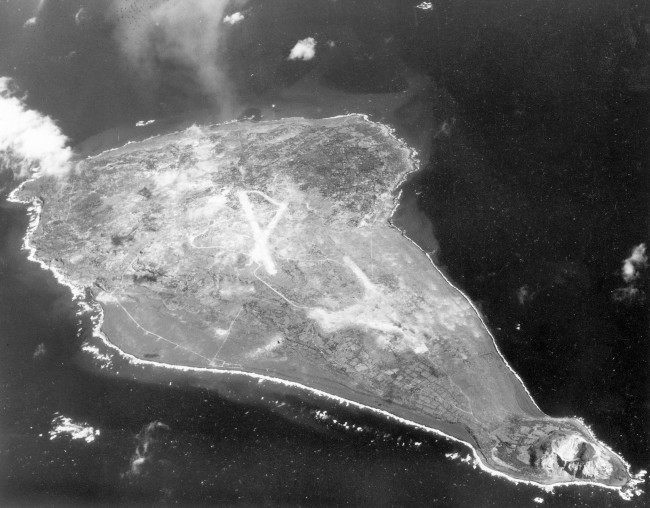
Not all of Rosenthal’s pictures were as memorable.

But those in the picture became legend:
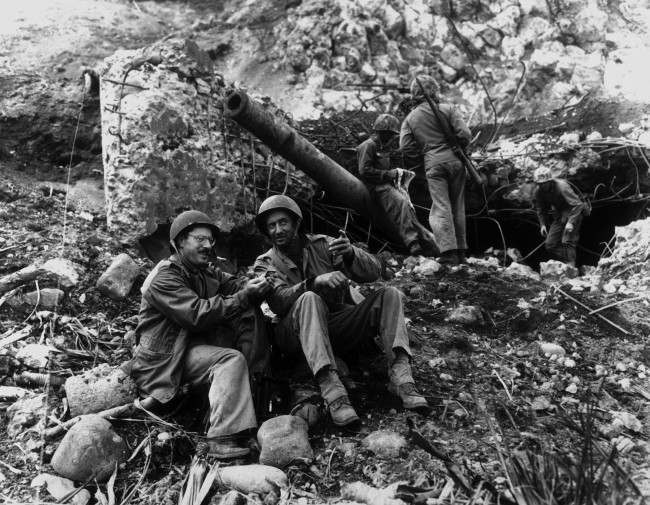
Joe Rosenthal, left, AP photographer with the wartime pool, takes time out to rest, March 2, 1945, with Bob Campbell, a Marine from San Francisco, in front of a large Japanese gun knocked out by Marines at the base of Mt. Suribachi. Rosenthal scaled the mountain to make the picture of the U.S. flag being raised there.
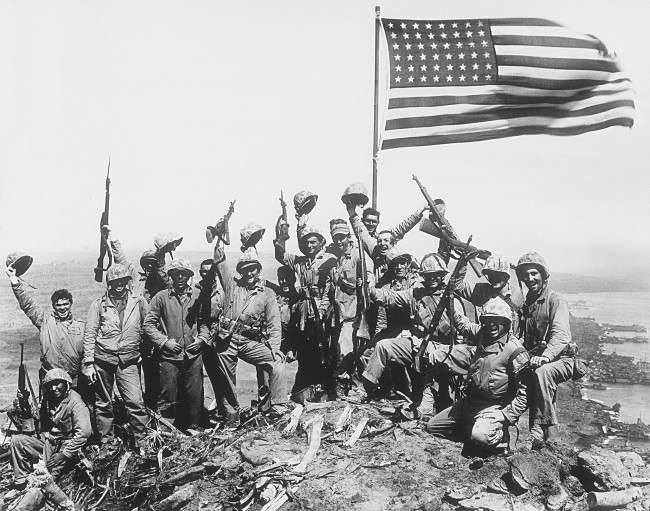
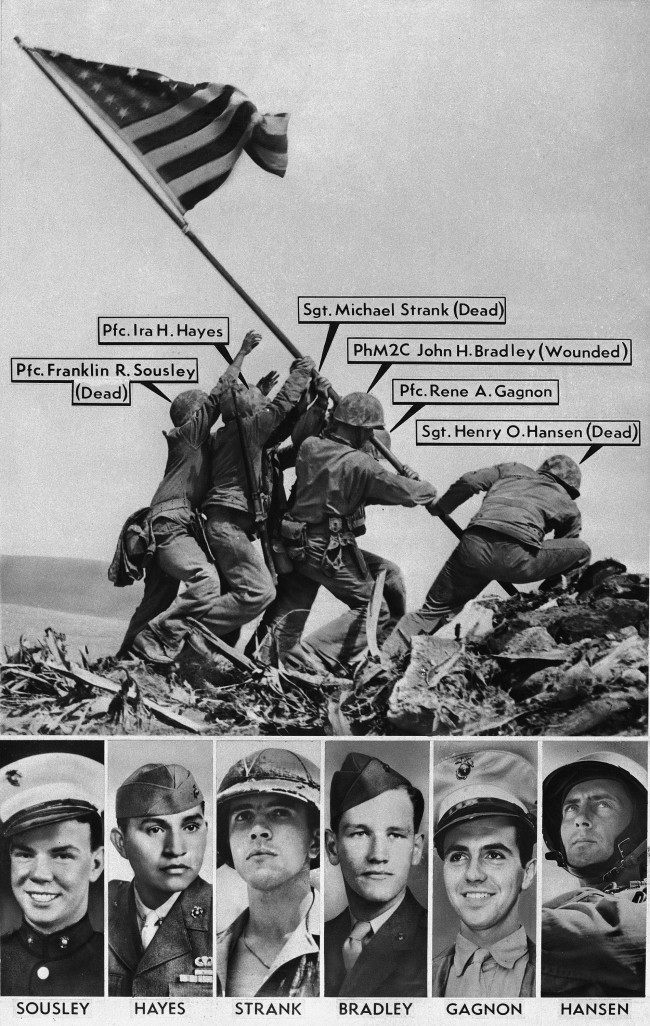
Joe Rosenthal’s Pulitzer Prize winning AP photo of the Feb. 23, 1945 flag raising on Mt. Suribachi, Iwo Jima, was originally misidentified by military sources. Originally identified, from left, in this vintage graphic: Pfc. Franklin R. Sousley; Pfc. Ira Hayes; Sgt. Michael Strank; Pharmacist’s Mate 2nd Class John H. Bradley; Pfc. Rene A. Gagnon; Sgt. Henry O. Hansen. The Marine at far right was later correctly identified as Cpl. Harlon Block, not Hansen.
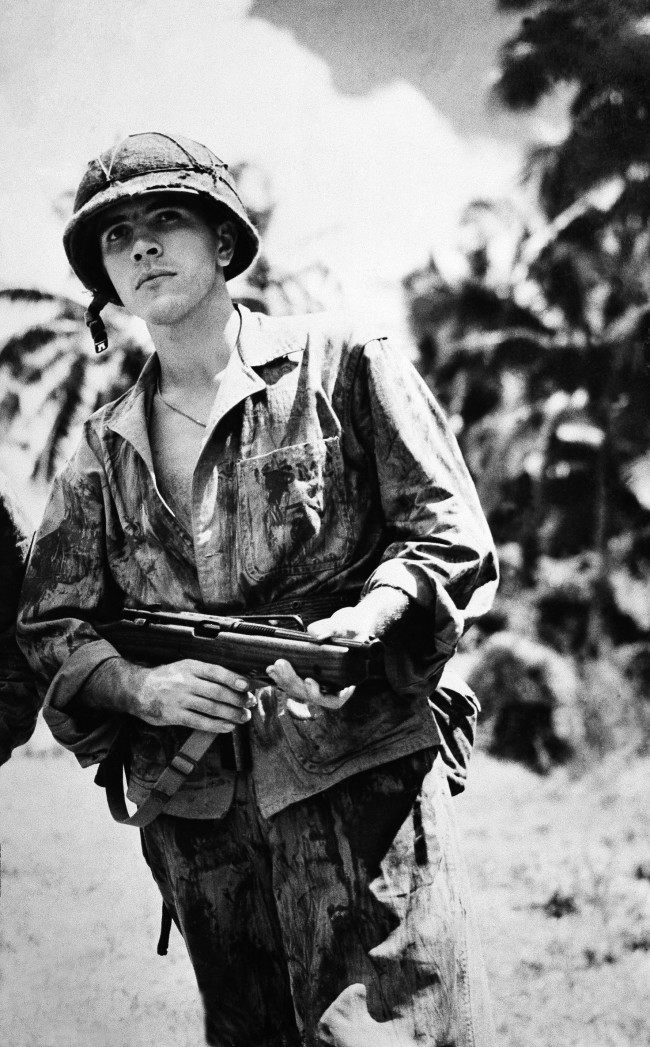
Marine Sgt. Michael Strank of Conemaugh, PA., reported killed in action on Iwo Jima, was identified on April 8, 1945 as one of the marines shown raising the stars and stripes on Mount Suribachi in Associated Press photographer Joe Rosenthal’s historic picture.
The picture was propaganda.
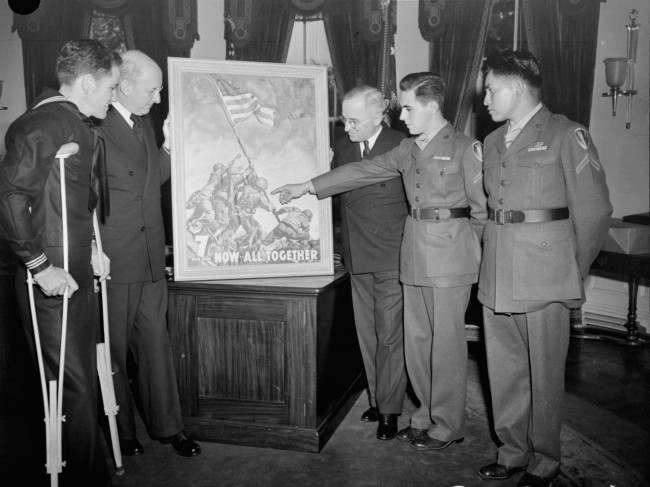
With the three survivors of the famed Mt. Suribachi flag-raising incident as his guests, President Truman gets the first of the new 7th war loan posters, based on Joe Rosenthal’s epic Iwo Jima photograph, at the White House, April 20, 1945. Left to right: John H. Bradley, of Appleton, Wisconsin; Secretary of the Treasury Henry Morgenthau, obscured; President Truman; Pfc. Rene A. Gagnon of Manchester, N.H.; Pfc. Ira H. Hayes, Bapchule, Az.
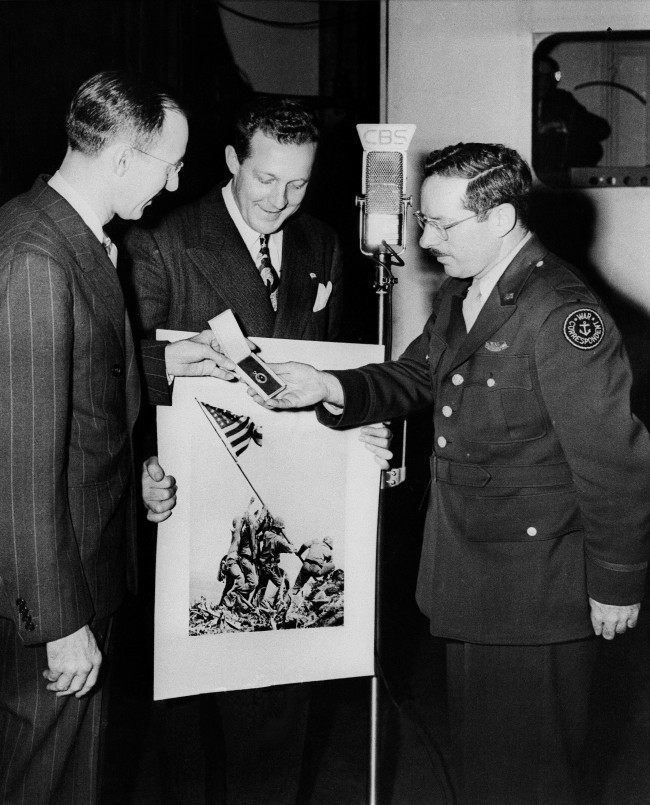
Joe Rosenthal, Associated Press photographer whose shot of the flag raising on Iwo Jima has become a classic, received further recognition when he was awarded the Graflex Diamond Award during an appearance on the “We, The People” television broadcast, April 1, 1945. From left to right: H.A. Schumacher, Vice President of the Former Graflex Corporation, who made the presentation on the air; Milo Boulton, emcee of the program, and Rosenthal. The twenty-sixth presentation, it was the first time that the Graflex Diamond Award has been made during the war.
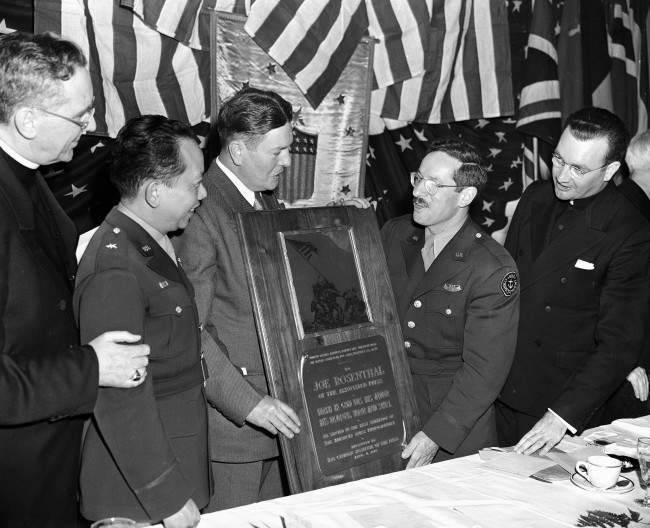
Joe Rosenthal, second from right, Associated Press photographer who took the famed Iwo Jima flag raising picture, is awarded a plaque at a Communion breakfast in New York, April 8, 1945. Looking on from left: Auxiliary bishop James Francis McIntyre of New York; Brig. Gen. Carlos P. Romulo, commissioner of the Philippines; Edward A. Mahar of the Catholic Institute of the Press; Rosenthal; Moderator Rev. Aloysius F. Coogan.
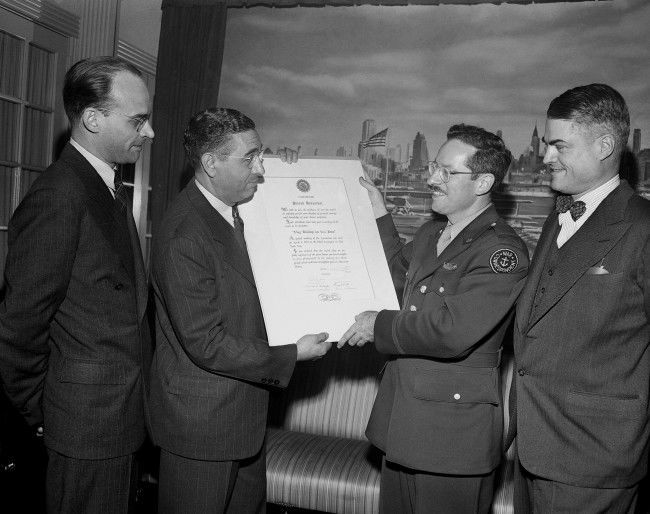
Joe Rosenthal, second from right, Associated Press staff photographer, receives a scroll from Joe Costa on behalf of the Press Photographers Association of New York in a ceremony commending him for his photo of the flag raising on Iwo Jima, in New York, April 4, 1945. Costa is president of the association.
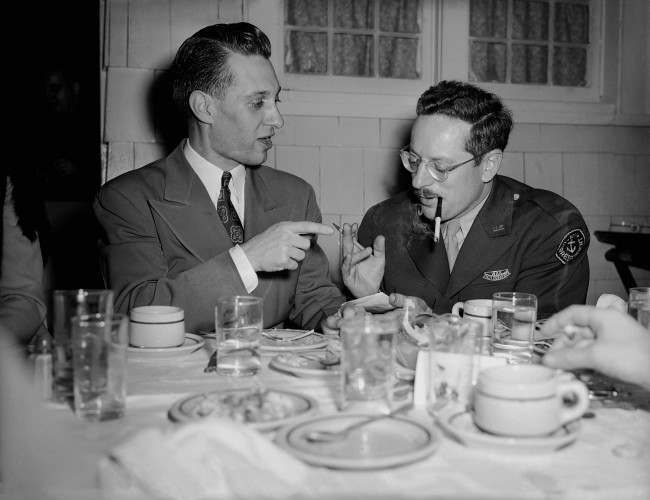
Associated Press photographer Joe Rosenthal, right, whose Iwo Jima Mount Suribachi flag-raising picture has made pictorial history, and Howard L. Kany, left, Washington news photo editor, enjoy a dinner in Joe’s honor, given during his visit to Washington by the AP Washington NewsPhoto staff at the Purple Iris Inn, March 30, 1945. Thirty-seven staffers, their wives, friends and Marines attended.
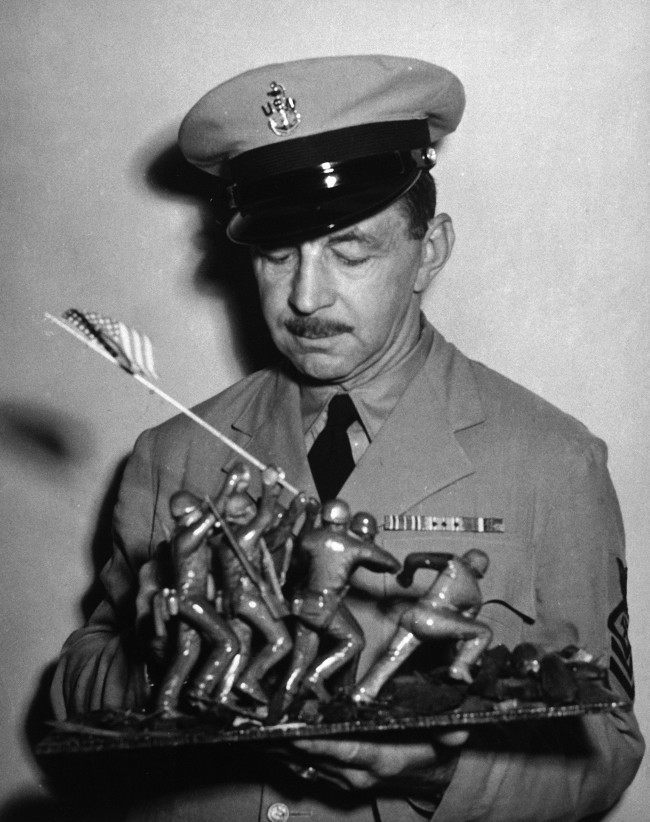
AP photographer Joe Rosenthal, seen Sept. 28, 1945, holds a wood carving depicting his famous photo of the flag raising at Iwo Jima.
The offensive.
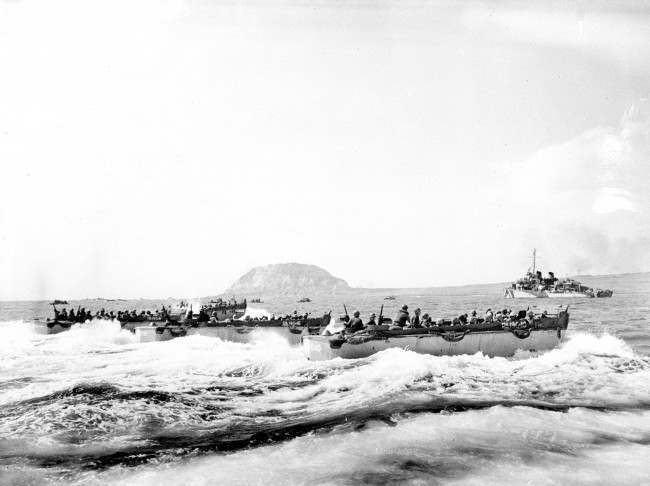
U.S. Marines aboard a landing craft head for the beaches of Iwo Jima Island, Japan, on Feb. 19, 1945 during World War II. In the background is Mount Suribachi, the extinct volcano captured by the Marines after a frontal assault.
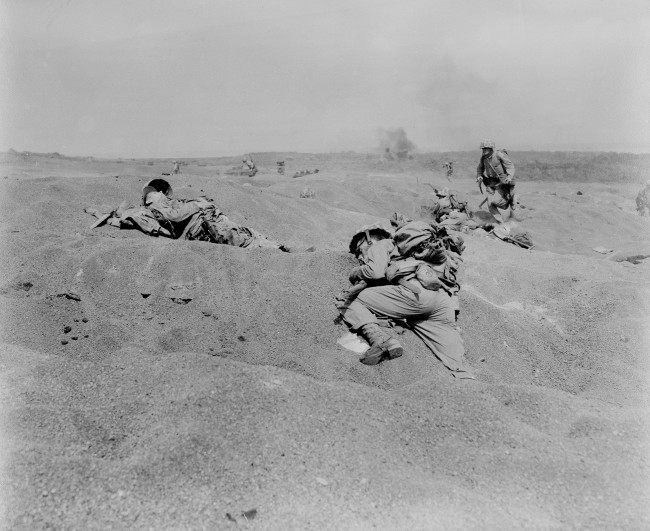
Two U.S. Marines, slumped in death, lie where they fell on Iwo Jima, among the first victims of Japanese gunfire as the American conquest of the strategic Japanese Volcano Island begins on Feb. 19, 1945 during World War II.
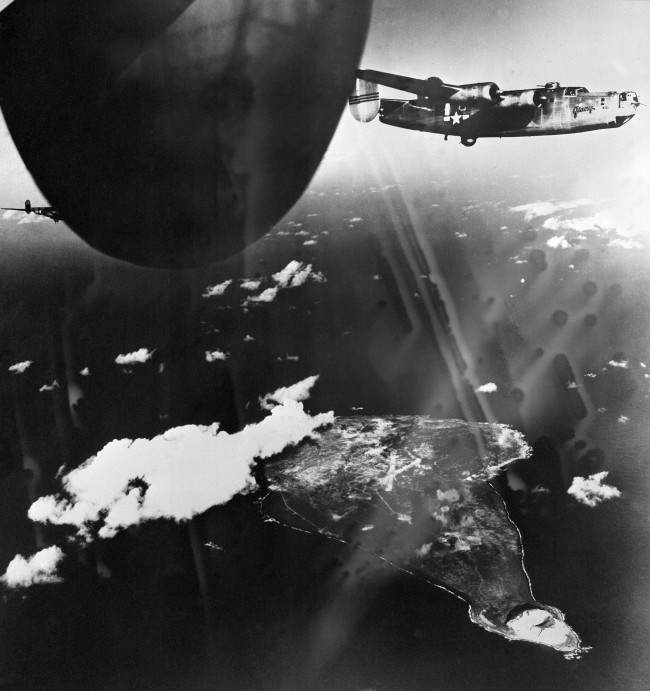
While U.S. B-24 (Liberators) soar high above the Japanese airbase on Iwo Jima in the Volcano Islands, Japan, bombs dropped from the planes explode on the island on Dec. 21, 1944. Volcano at lower tip of island.
The Japanese army and naval troops under Lt-General Kuribayashi Tadamichi fought to the death but the US Marines finally secured the whole island on 26 March in one of the bloodiest battles of the war.
Out of the 74,000 Marines that landed more than a third were killed or wounded.
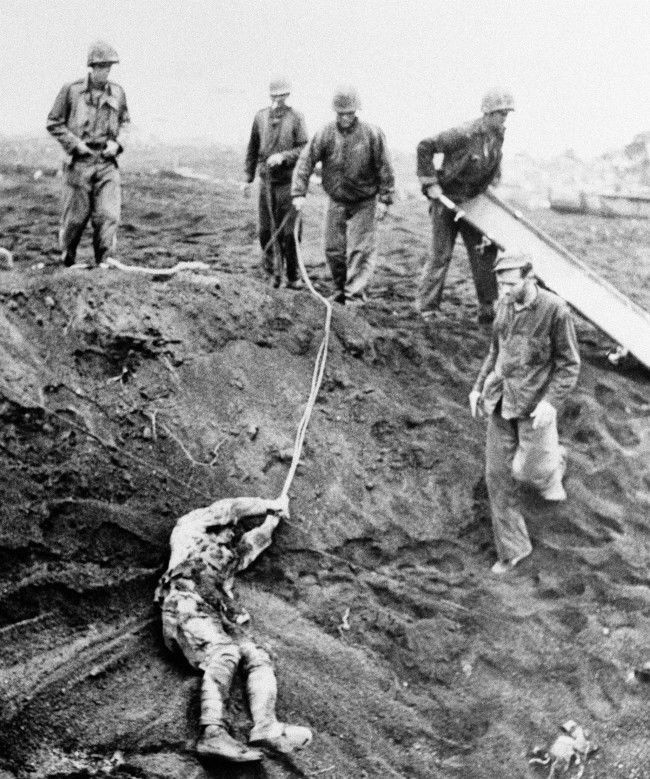
The first Japanese prisoner to be taken on Iwo Jima, Japan, is dragged from shell hole on May 16, 1945, where he lay buried for 1œ days, playing dead to Marines who used it for a fox hole. After knocking away a live grenade that lay a few inches from his hand, Marines dragged him out after he promised an interpreter that he would offer no resistance. A stretcher was thrown down and he rolled on it and was then lifted out.
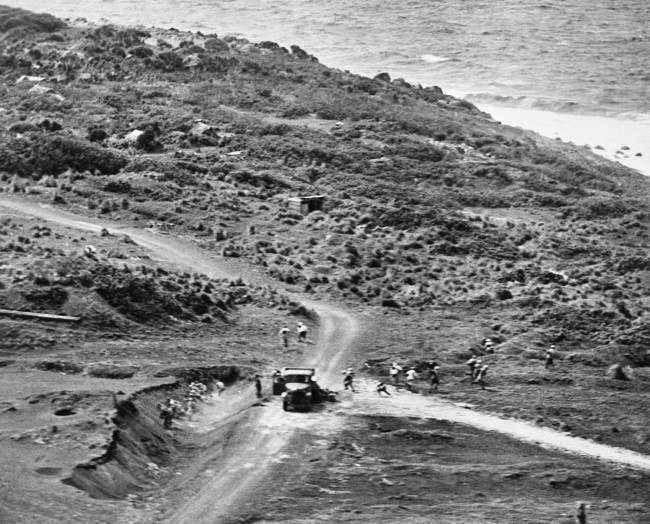
Near a truck on an Iwo Jima road in Japan on Feb. 20, 1945, Jap soldiers with field packs scatter for cover, as an American plane comes in low to strafe the enemy during pre-invasion softening-up. Japs at left dive into a gully; those at right head for a ravine; and others hide under the truck.
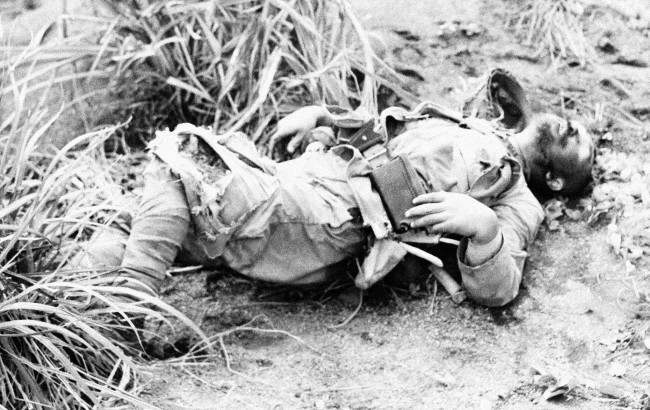
Japanese soldier is seen Feb. 23, 1945 on Iwo Jima, Japan, edge of Motoyama Airfield No. 1.

Coast Guardsman Charles R. Roth (right center), PHM/2c, of 296 prospect St., Lawrence, Mass., leads the singing of hymns on an LST headed for Iwo Jima, on the day before the invasion Feb. 26, 1945.
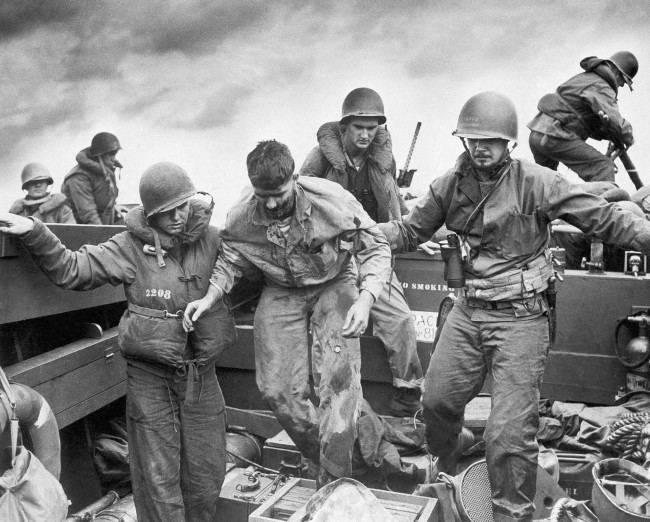
Wounded when Jap fire made a direct hit on an Amtrac, a Marine is transferred by Coast Guardsmen to a landing craft off the flaming shore of Iwo Jima, Japan on D-Day on Feb. 28, 1945.
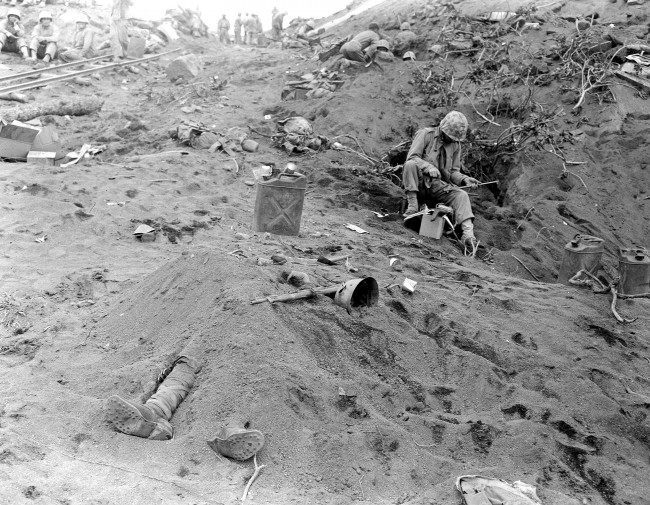
The booted feet of a dead Japanese soldier, foreground, protrude from beneath a mound of earth on Iwo Jima during the American invasion of the Japanese Volcano Island stronghold in 1945 in World War II. U.S. Marines can be seen nearby in foxholes.
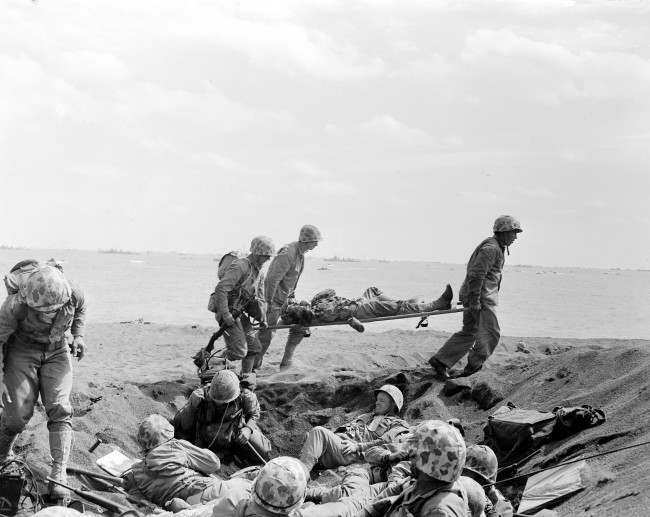
Corpsmen carry a wounded Marine on a stretcher to an evacuation boat on the beach at Iwo Jima while other Marines huddle in a foxhole during the invasion of the Japanese Volcano Island stronghold in this file photo of Feb. 25, 1945. A search team is on the island looking for a cave where the Marine combat photographer who filmed the famous World War II flag raising 62 years ago is believed to have been killed in battle nine days later, military officials said Friday, June 22, 2007. The team, from the Joint POW/MIA Accounting Command, based at Hickam Air Force Base in Hawaii, is on Iwo Jima looking for the remains of Sgt. Willam H. Genaust and “as many other American servicemen as they can find,” JPAC spokesman Lt. Col. Mark Brown told The Associated Press.
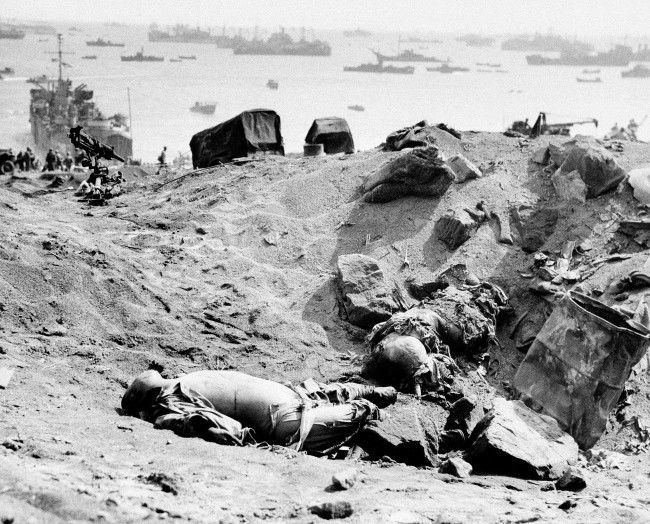
Two Japanese soldiers lay dead from the invasion armada seen in the background in Japan on March 1, 1945. A Coast Guard LST pushes its blunt nose on the beach at left, discharging heavy mechanized equipment.
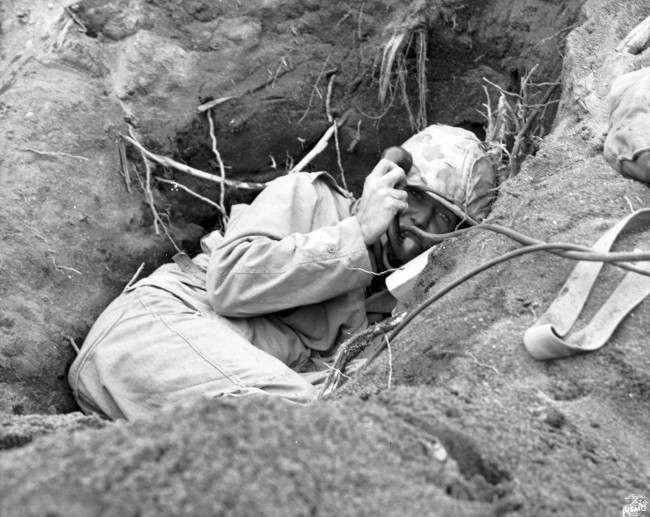
This is a March, 1945 photo of a U.S. Marine communicator, burrowed in a shallow foxhole, calling for artillery support to silence enemy mortars in Iwo Jima, Japan, during World War II.
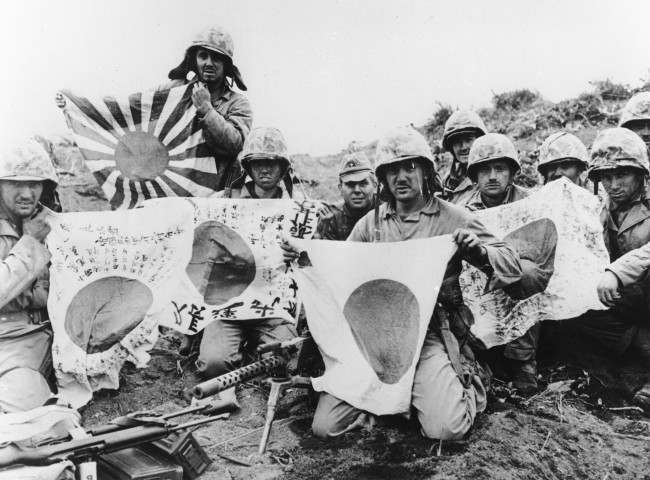
U.S. Marines of the 5th Division pose with captured Japanese battle flags, at Iwo Jima, on March 2, 1945.
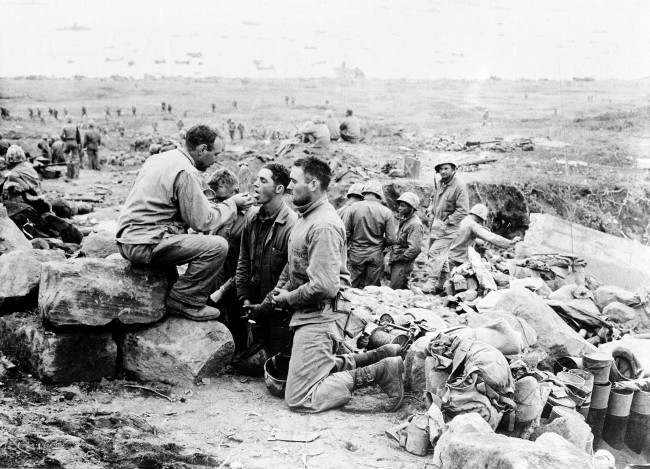
U.S. Marines receive communion from a Marine chaplain on Iwo Jima, the largest of the Japanese Volcano Islands, on March 3, 1945 during World War II.
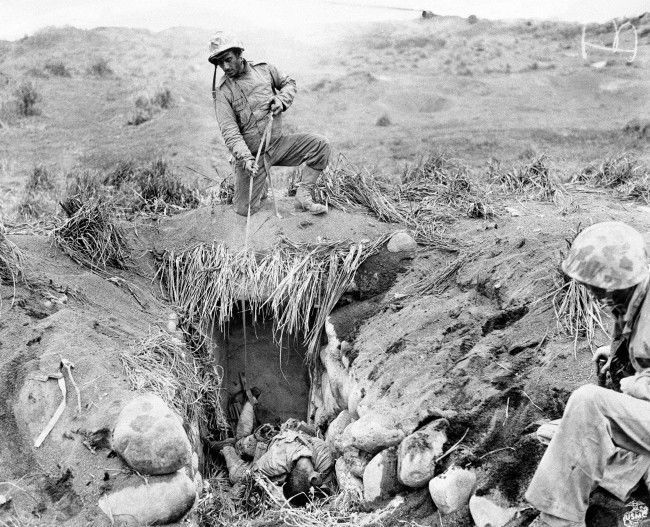
Battle-wise Marines use a sling made of enemy puttees to improvise a sling for the removal of a Japanese soldier’s body from a dugout on Iwo Jima, Japan on March 3, 1945, to safeguard against booby traps and possible attack from foes only pretending to be dead.
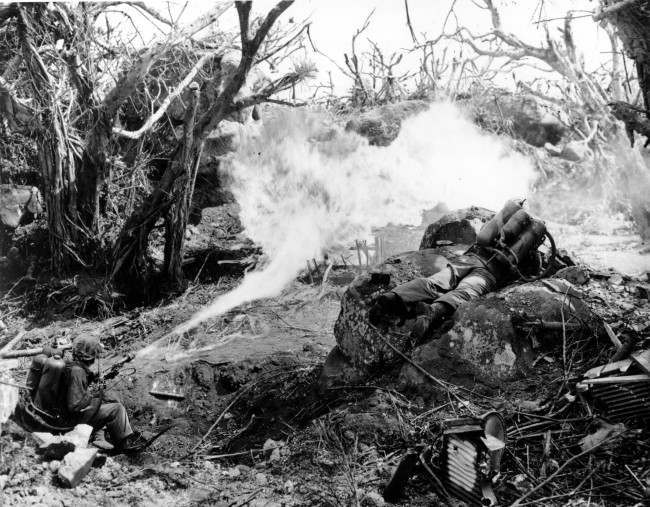
Two U.S. Marines directing flame throwers at Japanese defenses that block the way to Iwo Jima’s Mount Suribachi on March 4, 1945 during World War II. On the left is Pvt. Richard Klatt, of North Fond Dulac, Wis., and on the right is PFC Wilfred Voegeli.
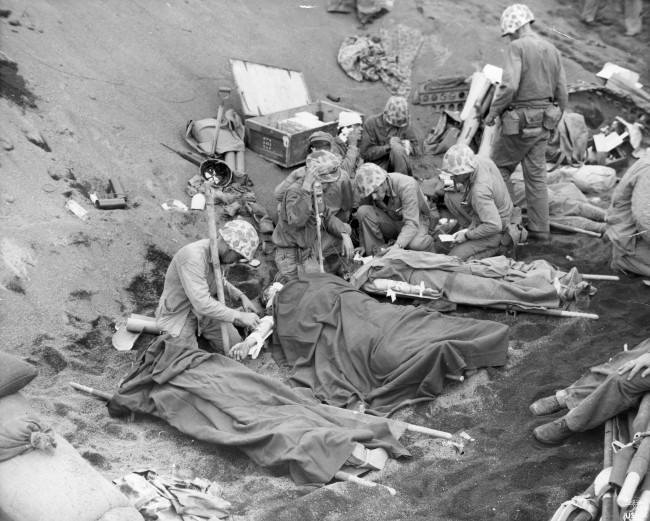
U.S. Navy doctors and medical corpsmen treat wounded U.S. Marines at an aid station established in a gully on Iwo Jima in the Pacific, Japan, on March 6, 1945 during World War II. Blood plasma and whole blood is administered from supplies flown from the west coast of the U.S.
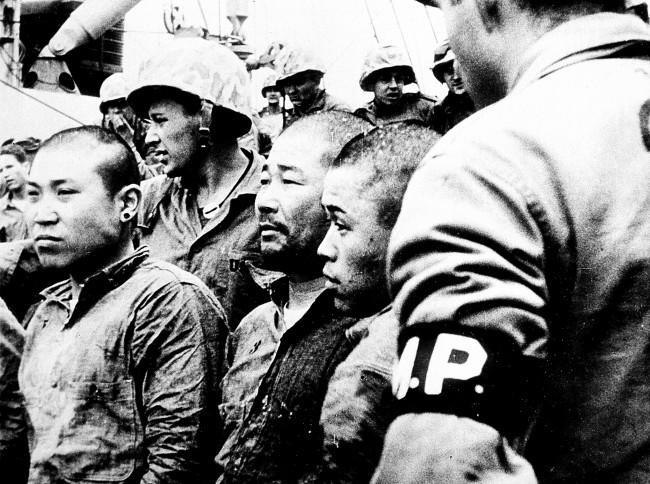
Three Japanese prisoners of war are shown aboard a U.S. Navy vessel in Japan on March 7, 1945 during World War II. They are among the few defenders captured alive on Iwo Jima.
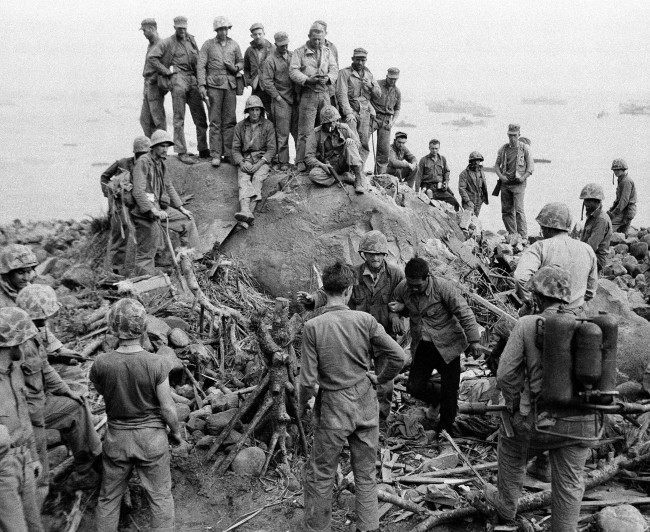
While his buddies stand around to watch, a Third Division Marine brings in a Japanese prisoner, one of the few enemy taken alive during the fighting on Iwo Jima, Japan on March 8, 1945.
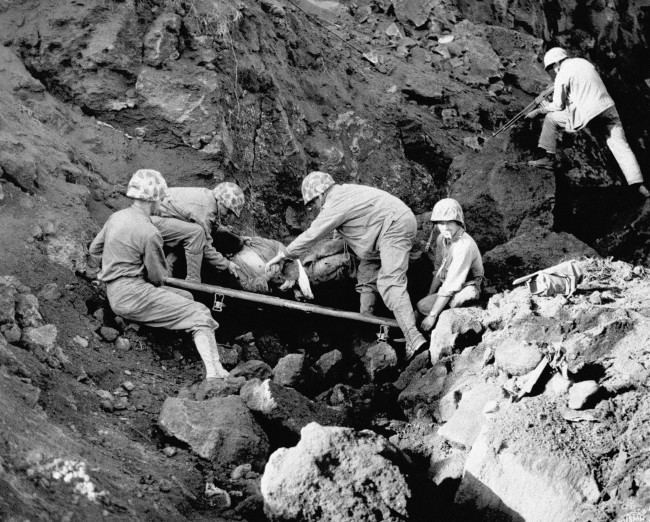
Marine stretcher bearers place a Japanese prisoner on a litter to be carried to the rear, while another Marine covers a cave entrance with his automatic rifle at northern Iwo Jima, Japan on March 17, 1945. According to the Marine Corps, this prisoner gave up when he couldn’t hold out any longer after ten days without food or water.
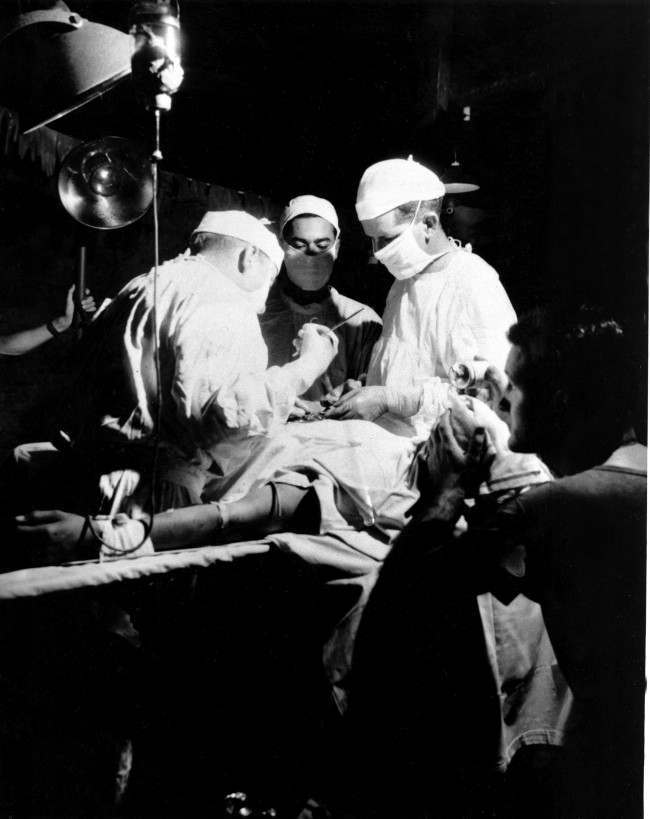
While a U.S. corpsman administers ether, Navy doctors operate to remove shrapnel from the abdomen of a wounded leatherneck at the Fourth Marine Division evacuation hospital in Iwo Jima, Japan, on March 14, 1945. The makeshift operating room is at an abandoned Japanese dugout several thousand yards from the front lines in World War II.
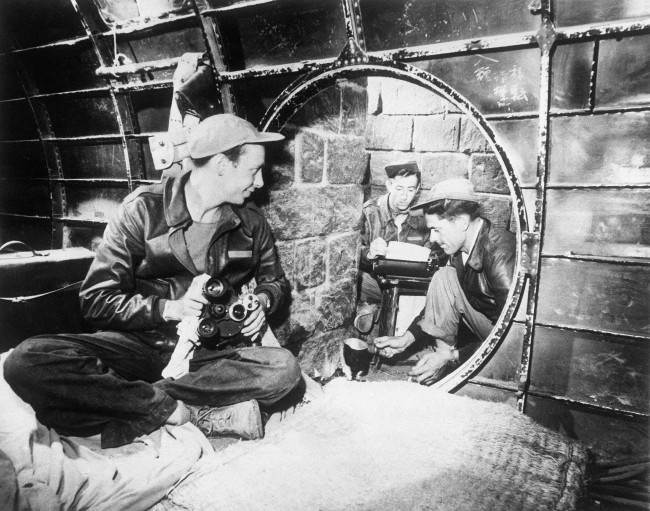
Twelve feet below the surface near an Iwo Jima airstrip, Japan, three 7th AAF combat cameramen establish their headquarters in a former Japanese underground quarters made of a wrecked bomber fuselage and stone blocks on April 10, 1945.
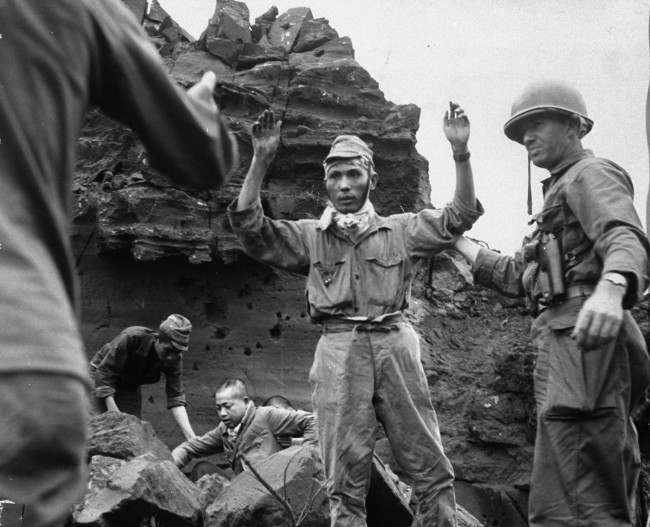
With his hands in the air, the first of 20 Japanese emerges from an Iwo Jima cave on April 5, 1945. The group had been hiding for several days.
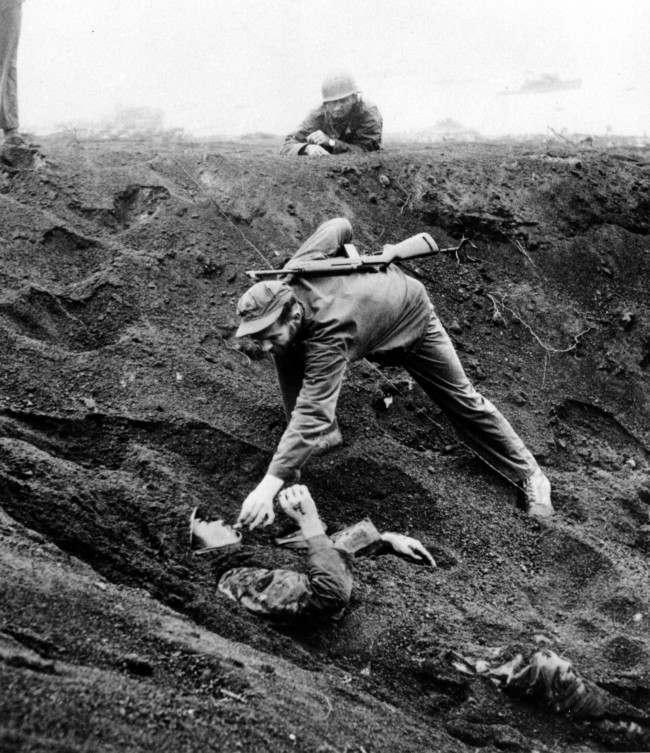
A U.S. Marine approaches a Japanese soldier on Iwo Jima, Japan, on March 16, 1945 during World War II. The Japanese soldier was buried for 1 1/2 days in this shell hole playing dead and ready with a live grenade inches away from his hand. The Marines feared he might be further booby trapped underneath his body after knocking the grenade to the bottom of the shell hole. Promising no resistance, the prisoner is given a cigarette that he asked for and was dragged free from the hole.
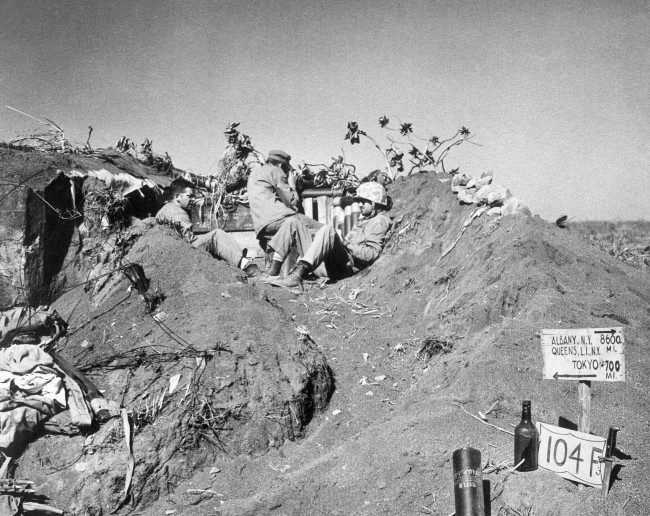
U.S. Marines with a coast guard combat photographer found crouching in a listening post dug in Iwo Jima’s coffee grounds sands, Japan on March 16, 1945.
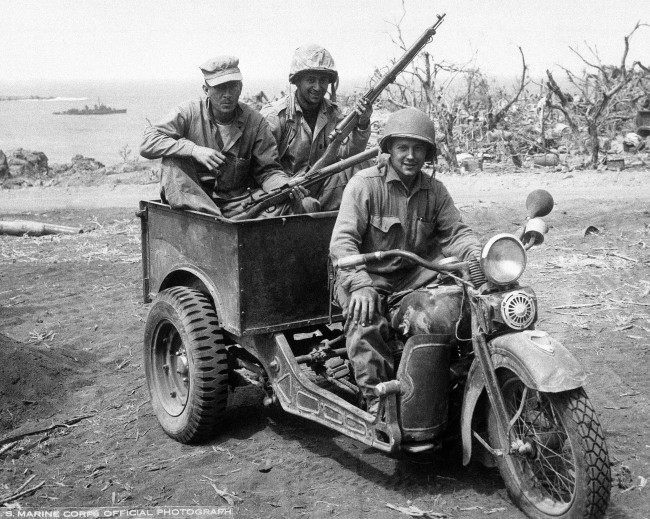
Japanese 3 wheel motorcycle repaired by U.S. Marines for own use. Photographed as action continued on Iwo Jima, Japan on April 16, 1945.
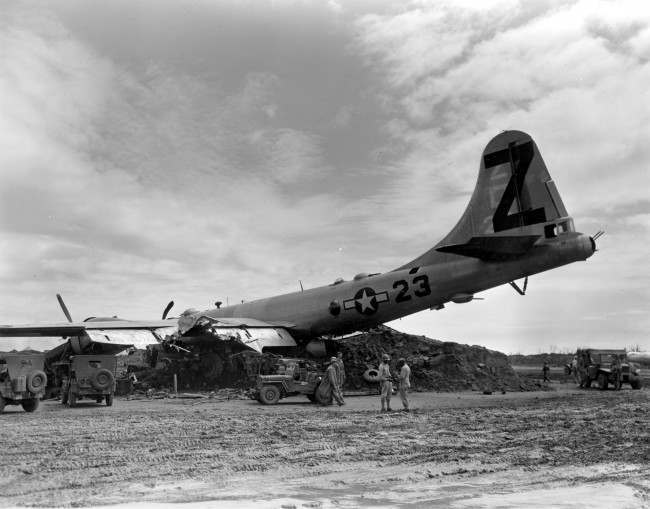
A B-29 Superfortress rests on a dirt mound after it crash landed with two engines working at Iwo Jima, Japan, on April 21, 1945 during World War II. The U.S. Air Force plane was damaged in a raid over Tokyo.
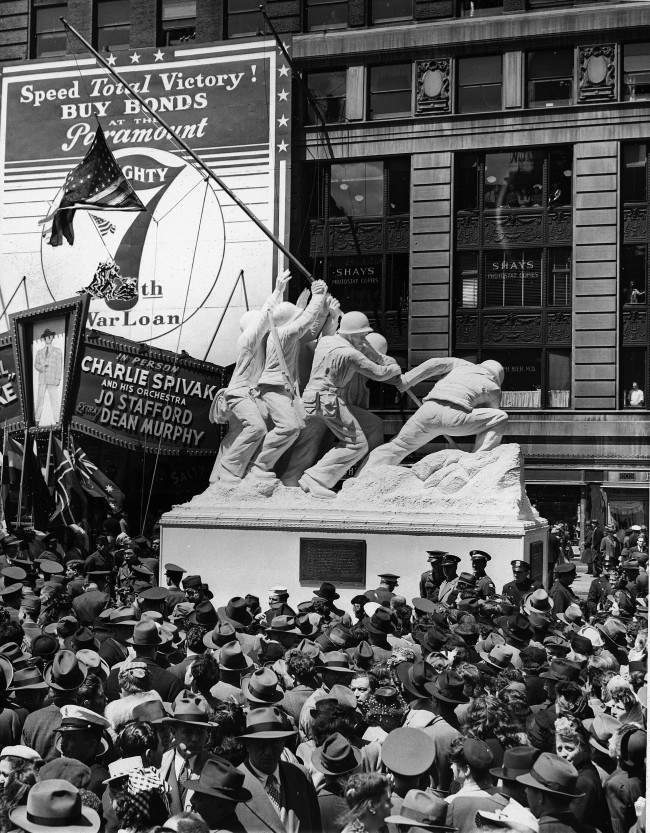
Hundreds look on during the unveiling of the 50-foot statue of the Iwo Jima flag-raising, a reproduction of AP photographer Joe Rosenthal’s Pulitzer Prize winning picture, May 11, 1945. The unveiling, at Times Square in New York, officially opened the 7th War Loan Drive. The original flag raised on Iwo Jima is used on the statue.

This is a March, 1945 photo of U.S. Marines preparing graves in the cemetery of the third and Fourth Marine Divisions for their buddies who died in taking the island of Iwo Jima, Japan, during World War II.
A memorial based on the photo stands at Arlington Cemetery, Virginia.
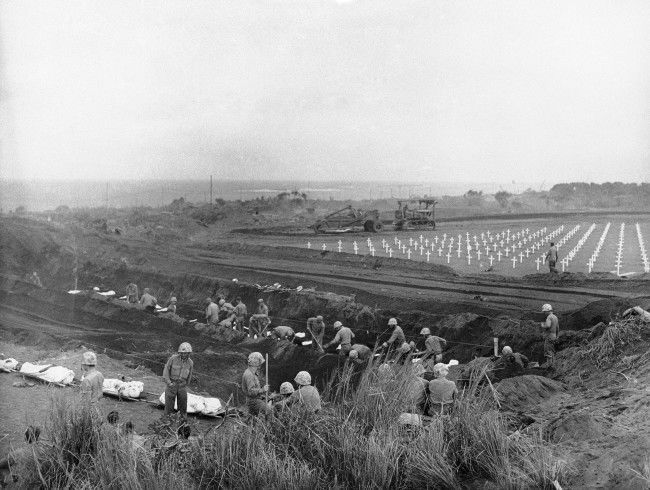
U.S. Marines dig graves in the Fifth Marine Division cemetery on Iwo Jima, Japan, for the shrouded bodies of their buddies on March 30, 1945.
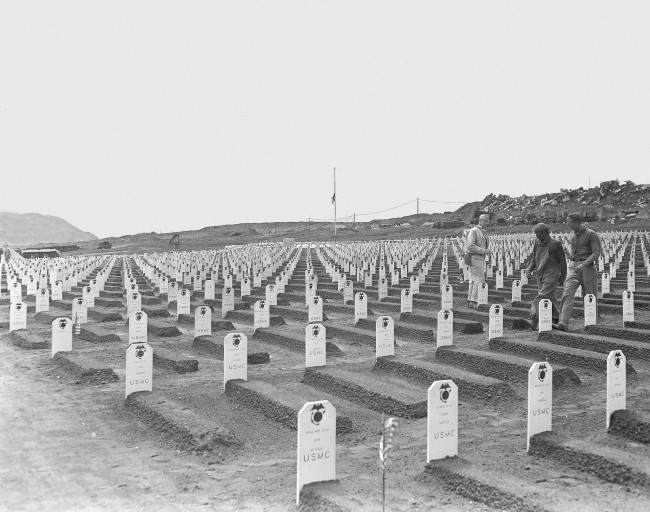
White markers designate the final resting place for hundreds of Third and Fourth Marine Division fighters, who died during invasion of Iwo Jima in World War II, in this cemetery located near the beach where the U.S. Marines first established a beachhead, April 1945. In the background, an American flag flies at half staff in tribute to the late President Franklin D. Roosevelt, who died in Warm Springs, Ga., on April 12.
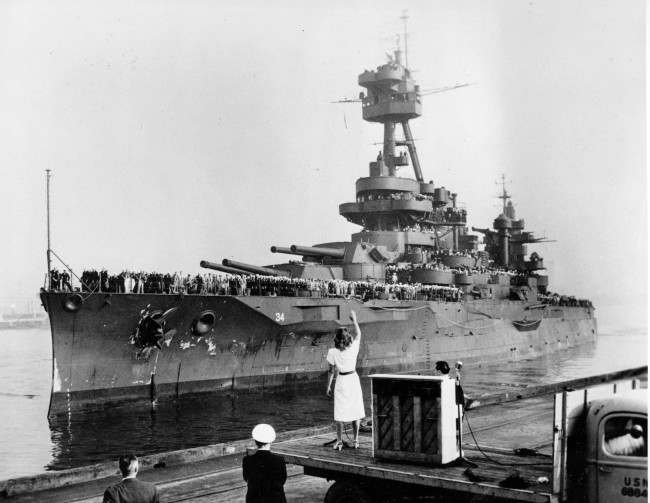
The battleship USS New York, veteran of the Okinawa and Iwo Jima campaigns, returns with World War II veterans at San Pedro, Ca., Sept. 9, 1945. Radio and screen personality Dinah Shore, foreground, accompanied by a piano player, waves from a truckbed waiting to entertain the crew. Date: 09/09/1945
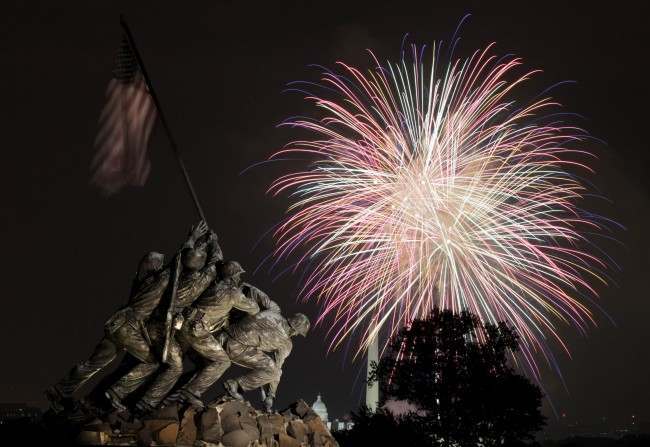
The United States Marine Corps War Memorial, better known as the Iwo Jima Memorial, is seen in Arlington, Va., Monday July 4, 2011, as fireworks burst over Washington, during the annual Fourth of July display. The Washington Monument and the Capitol can be seen in the distance.
Iwo Jima was returned to Japan in 1968.
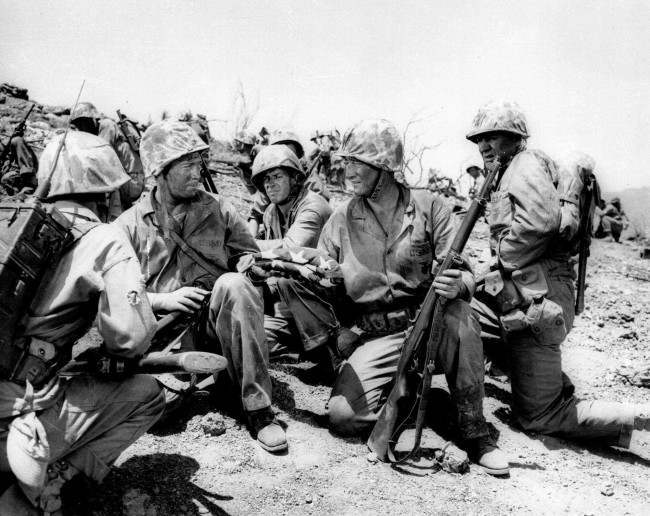
In the movie reproduction of the flag raising scene on Iwo Jima, Capt. H.G. Schrier, left, who actually carried the flag up Mt. Surabachi, hands the flag to John Wayne. Date: 08/06/1975
And then…
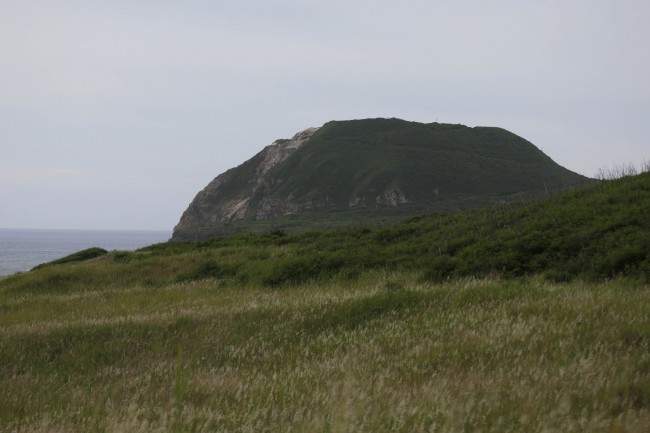
Mt. Suribachi, is seen from Invasion Beach on Iwo Jima, Japan, Friday, June 7, 2013. Iwo Jima, now known officially as Ioto, one of the most iconic battlegrounds of WWII, is today inhabited only by Japanese troops, and is used by the U.S. military for training.

Photographer Joe Rosenthal poses for a photo at the New Pisa Bar and restaurant Monday, Dec. 20, 1994, in San Francisco. Rosenthal, the photojournalist whose Pulitzer Prize-winning image of World War II servicemen raising an American flag over Iwo Jima became the model for the Marine Corps War Memorial, has died. He was 94. Rosenthal, who took the iconic photograph on Feb. 23, 1945 while working for The Associated Press, died Sunday, Aug. 20, 2006, of natural causes at an assisted living facility in suburban Novato, Calif., said his daughter, Anne Rosenthal.

ormer U.S. soldier fighting on Iwo Jima during the World War II, Franklin Hobbs, right, and Chie Takekawa, whose father was killed in the same battle, hold a framed letter and a photo of her sister during a press conference at the Foreign Correspondents Club of Japan in Tokyo, Thursday, Oct. 28, 2010. The faded photograph of a baby Japanese girl and colorful drawing of an air raid drill were quietly stored away in the home of Franklin Hobbs III. As a 21-year-old American GI fighting on Iwo Jima, one of the bloodiest battles of World War II, Hobbs found them in the chest pocket of a fallen Japanese soldier and took them home as a souvenir.
Would you like to support Flashbak?
Please consider making a donation to our site. We don't want to rely on ads to bring you the best of visual culture. You can also support us by signing up to our Mailing List. And you can also follow us on Facebook, Instagram and Twitter. For great art and culture delivered to your door, visit our shop.

